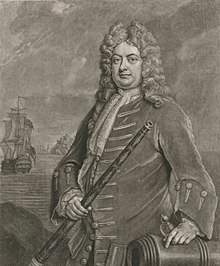Robert Hughes (Royal Navy officer, died 1729)
Robert Hughes | |
|---|---|
| Died | 14 March 1729 London, England |
| Buried | St Paul's, Deptford, England |
| Allegiance | Kingdom of Great Britain |
| Service | Royal Navy |
| Years of service | c.1692–1729 |
| Rank | Rear-Admiral |
| Commands | |
| Battles / wars | |
| Children | 2 |
| Relations | Sir Richard Hughes (nephew) Sir Robert Calder (grandson) |
Hughes commanded a
Naval service
Early career
Robert Hughes was born in the late seventeenth century. He was the brother of
Command
At the same time as his promotion to captain Hughes was given command of the 24-gun sixth-rate HMS Flamborough; he continued in the ship after the end of the Nine Years' War later in the year. The following year, the ship sailed as escort to a convoy travelling through the White Sea, before in 1699 serving off the coast of Ireland. Flamborough then saw service guarding the Great Yarmouth fisheries in 1701, with the War of the Spanish Succession beginning in the same year.[4][5] At this point Flamborough was sent to serve as a cruiser in the North Sea.[5] Hughes captured several small but successful privateers around Dunkirk in 1702, demonstrating "great activity and diligence" according to biographer John Charnock.[6]

Towards the end of the year Hughes was transferred to command the 50-gun ship of the line
Hughes was at this point moved with Winchester to serve in the English Channel again, and on 27 November captured a privateer from Flushing.[8] In 1711 Hughes was given command of the 70-gun ship of the line HMS Kent, serving in the Channel as the flagship of Rear-Admiral Sir Thomas Hardy.[9] Kent captured the privateer La Revanche on 23 February the following year.[10]
Hughes was moved to command the 60-gun ship of the line
Flag rank
Hughes was promoted to rear-admiral on 21 April 1727.
Personal life
Hughes married a woman named Lydia, with whom he had two daughters who became his co-heiresses.[14] One daughter, Alice, married Sir James Calder, 3rd Baronet. She had four sons, including Admiral Sir Robert Calder.[15] His other daughter, Katherine, married John Sayer and had a son, Vice-Admiral James Sayer.[14]
Notes and citations
Notes
- rear-admiral of the red 19 July 1728.[2]
Citations
- ^ Harrison (2019), p. 271.
- ^ a b c Syrett & DiNardo (1994), p. 233.
- ^ Charnock (2011), p. 165.
- ^ Winfield (2009), p. 639.
- ^ a b Charnock (2011), pp. 165–166.
- ^ a b c d e f Charnock (2011), p. 166.
- ^ Winfield (2009), p. 578.
- ^ a b c Winfield (2009), p. 469.
- ^ Winfield (2009), p. 308.
- ^ Winfield (2007), p. 137.
- ^ Clowes (1898), p. 47.
- ^ Charnock (2011), p. 167.
- ^ "London". Newcastle Weekly Courant. 8 March 1729. p. 2.
- ^ a b c Dugdale (1853), p. 538.
- ^ Annual Biography (1820), p. 2.
References
- ISBN 978-1-108-02633-8.
- OCLC 960656995.
- Dugdale, Thomas (1853). England and Wales Delineated. Vol. 1. London: L. Tallis. OCLC 492541356.
- Harrison, Cy (2019). Royal Navy Officers of the Seven Years War. Warwick, England: Helion. ISBN 978-1-912866-68-7.
- Syrett, David; DiNardo, R. L. (1994). The Commissioned Sea Officers of the Royal Navy 1660–1815. Aldershot: Scolar Press. ISBN 1-85928-122-2.
- The Annual Biography and Obituary. Vol. 4. London: Longman, Hurst, Rees, Orme, and Brown. 1820. OCLC 867871827.
- Winfield, Rif (2009). British Warships in the Age of Sail 1603–1714. Barnsley, South Yorkshire: Seaforth. ISBN 978-1-78346-924-6.
- Winfield, Rif (2007). British Warships in the Age of Sail 1714–1792: Design, Construction, Careers and Fates. London: Pen & Sword. ISBN 978-1-84415-700-6.
